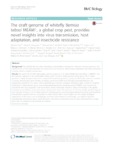Por favor, use este identificador para citar o enlazar este ítem:
http://www.alice.cnptia.embrapa.br/alice/handle/doc/1058708| Título: | The draft genome of whitefly Bemisia tabaci MEAM1, a global crop pest, provides novel insights into virus transmission, host adaptation, and insecticide resistance. |
| Autor: | CHEN, W.  HASEGAWA, D. K.   KAUR, N.   KLIOT, A.   PINHEIRO, P. V.   LUAN, J.   STENSMYR, M. C.   ZHENG, Y.   LIU, W.   SUN, H.   XU, Y.   LUO, Y.   KRUSE, A.   YANG, X.   KONTSEDALOV, S.   LEBEDEV, G.   FISHER, T. W.   NELSON, D. R.   HUNTER, W. B.   BROWN, J. K.   JANDER, G.   CILIA, M.   DOUGLAS, A. E.   GHANIM, M.   SIMMONS, A. M.   WINTERMANTEL, W. M.   LING, K.-S.   FEI, Z.   |
| Afiliación: | WENBO CHEN; DANIEL K. HASEGAWA; NAVNEET KAUR; ADI KLIOT; PATRICIA VALLE PINHEIRO, CNPAF; JUNBO LUAN; M. C. STENSMYR; YI ZHENG; WENLI LIU; HONGHE SUN; YIMIN XU; YUAN LUO; ANGELA KRUSE; XIAOWEI YANG; SVETLANA KONTSEDALOV; GALINA LEBEDEV; TONJA W. FISHER; DAVID R. NELSON; WAYNE B. HUNTER; JUDITH K. BROWN; GEORG JANDER; MICHELLE CILIA; ANGELA E. DOUGLAS; MURAD GHANIM; ALVIN M. SIMMONS; WILLIAM M. WINTERMANTEL; KAI-SHU LING; ZHANGJUN FEI. |
| Año: | 2016 |
| Referencia: | BMC Biology, v. 14, p. 1-15, 2016. |
| Descripción: | Background: The whitefly Bemisia tabaci (Hemiptera: Aleyrodidae) is among the 100 worst invasive species in the world. As one of the most important crop pests and virus vectors, B. tabaci causes substantial crop losses and poses a serious threat to global food security. Results: We report the 615-Mb high-quality genome sequence of B. tabaci Middle East-Asia Minor 1 (MEAM1), the first genome sequence in the Aleyrodidae family, which contains 15,664 protein-coding genes. The B. tabaci genome is highly divergent from other sequenced hemipteran genomes, sharing no detectable synteny. A number of known detoxification gene families, including cytochrome P450s and UDP-glucuronosyltransferases, are significantly expanded in B. tabaci. Other expanded gene families, including cathepsins, large clusters of tandemly duplicated B. tabaci-specific genes, and phosphatidylethanolamine-binding proteins (PEBPs), were found to be associated with virus acquisition and transmission and/or insecticide resistance, likely contributing to the global invasiveness and efficient virus transmission capacity of B. tabaci. The presence of 142 horizontally transferred genes from bacteria or fungi in the B. tabaci genome, including genes encoding hopanoid/sterol synthesis and xenobiotic detoxification enzymes that are not present in other insects, offers novel insights into the unique biological adaptations of this insect such as polyphagy and insecticide resistance. Interestingly, two adjacent bacterial pantothenate biosynthesis genes, panB and panC, have been co-transferred into B. tabaci and fused into a single gene that has acquired introns during its evolution. Conclusions: The B. tabaci genome contains numerous genetic novelties, including expansions in gene families associated with insecticide resistance, detoxification and virus transmission, as well as numerous horizontally transferred genes from bacteria and fungi. We believe these novelties likely have shaped B. tabaci as a highly invasive polyphagous crop pest and efficient vector of plant viruses. The genome serves as a reference for resolving the B. tabaci cryptic species complex, understanding fundamental biological novelties, and providing valuable genetic information to assist the development of novel strategies for controlling whiteflies and the viruses they transmit. |
| Thesagro: | Bemisia tabaci Mosca branca Praga de planta |
| NAL Thesaurus: | Plant pests Virus transmission Insecticide resistance |
| Palabras clave: | Polyphagy Whitefly Draft genome |
| DOI: | 10.1186/s12915-016-0321-y |
| Tipo de Material: | Artigo de periódico |
| Acceso: | openAccess |
| Aparece en las colecciones: | Artigo em periódico indexado (CNPAF)  |
Ficheros en este ítem:
| Fichero | Descripción | Tamaño | Formato | |
|---|---|---|---|---|
| CNPAF2016bmc.pdf | 2,15 MB | Adobe PDF |  Visualizar/Abrir |









